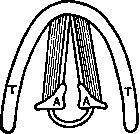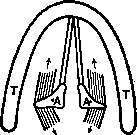Voice Training In Speech And Song - online tutorial
The Structure And Use Of The Vocal Organs, And The Means Of Securing Distinct Articulation.
| Share page | Visit Us On FB |
|
|
||||
|
12 |
THE VtBfcATORY APPARATTJ9. |
|||
|
|
||||
|
vocal cord and actually sending fibres right into the cords to be attached to the elastic fibres, may be called the vocal muscles, for if they are paralysed loss of voice ensues (Fig. 8). Their action is somewhat complicated, but in all probability they are the muscles which enable the voice-user to make use of the fine and delicate gradations of tone. |
||||
|
|
||||
 |
 |
|||
|
|
||||
|
Fig. 8.—The Arytenoid Cartilages, Fig. 9.—The Arytenoid Cartilages, |
||||
|
|
||||
|
A, allowing the Vocal Cords attached to their front processes. The Thyro-Arytenoid Muscle lies alongside each cord and passes from the Thyroid Cartilage, T, to the Arytenoid Cartilages. The two curved lines at the back of the Arytenoids represent the Arytenoid Muscle, which draws the Arytenoids together. |
A, with a dot representing the pivot around which each is moved by its own muscles. The front muscle, called the Lateral Crico-Arytenoid, is attached to the front of the outer process of the Arytenoid; it pulls it forward as shown by the arrow; this action approximates the Vocal Cords. The back muscle, called the Posterior Crico-Arytenoid, is attached to the back of the outer process of the Arytenoid; it pulls it backwards as shown by the arrow and separates the Vocal Cords. |
|||
|
|
||||
|
The movements which give rise to voice do not in reality consist of simple movements performed by a single muscle, but rather of combined and coordinated movements of more than one muscle. The mechanism is therefore too complicated for analysis, and it is this complication that gives the singer such a variety of pitch.
19. Changes in the Cords.—Many and contradictory theories have from time to time been advanced as to what |
||||
|
|
||||